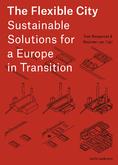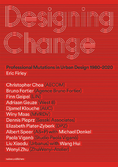downtowns urban theory information technology regulation large scale plans & projects smart city call for papers governance urbanism welfare spatial planning climate change waterfronts & harbors renaissance premio gubbio 2018 conservation & preservation inclusive processes representation open position fabrication technology land use scenarios progetto urbano news
THE FLEXIBLE CITY
Sustainable solutions for a Europe
in transition
by Tom Bergevoet and Maarten van Tuijl
Pages 368, 2016 | ISBN 9788867741670
The society of the future is not the backdrop to a science-fiction film. Right now, throughout Europe, you can find specific examples of solution how cities and regions are strengthening themselves, working on smart solutions to the complex issues they face. Urban regions, cities and villages are hives of activity, creating networks of innovation and experimentation that will provide answers to the challenges of today and tomorrow. Take, for example, climate change or urbanization. Or trends such as our increasing mobility and the need to keep cities accessible and liveable. Or how we need to make the transition to ‘the next economy’, which will be defined by sustainable energy and the circular economy.
This book is about spatial innovation in European cities and villages.
The writers, Tom Bergevoet and Maarten van Tuijl, view innovation as the key to making today’s European cities and villages future-proof and flexible. They use practical examples to show how we can make population centres more sustainable and make flexible use of the available space. Our use of space needs to be adaptable so as to accommodate the changing wishes and needs of urban populations and businesses. And there must be space to experiment and innovate – in villages with dwindling populations, for example, buildings that are not listed can be demolished and replaced by community gardens on the land that has been freed up as a result.
CONTENTS:
Foreword | 7
Prologue | 9
• The Inflexible City
Europe in Transition
The Need for Sustainable Solutions
System Crisis
From Urban Expansion to Reuse
From Supply to Demand
From Blueprint to Unpredictability
• The Flexible City
Flexible Planning
Local Flexibility
Use-driven Flexibility
Time-based Flexibility
How Does Flexible Planning Work?
• Instruments for a Flexible City
The Key Factors Determining Spatial Development
Organizational Flexibility
Organizational Instruments
Legal Flexibility
Legal Instruments
Financial Flexibility
Financial Instruments
Spatial Flexibility
Spatial Instrument
• Examples of a Flexible City
Dachausbauten, Vienna, Austria | Rückbau, Barkenberg, Germany | Byens Hegn, Copenhagen, Denmark | The White Meat City, Copenhagen, Denmark | Phénix Charleroi, Belgium | Fra tomt til gront, Vestervig, Denmark | Südstadt, Tübingen, Germany | Sargfabrik, Vienna, Austria | Neighbourhood Contract Navez-Portaels, Brussels, Belgium | Hotel de Marne, The Netherlands | Panorama West, Amsterdam, The Netherlands | Made in Marxloh, Duisburg, Germany | Open Lab Ebbinge, Groningen, The Netherlands | Park Hill, Sheffield, United Kingdom | Prinzesinnengarten, Berlin, Germany | Hummerhus, Klitmoller, Denmark | The Gerard Anton Buildings on Strijp-S, Eindhoven, The Netherlands | Grond en Pandenbeleid De Coninckplein, Antwerp, Belgium
Acknowledgements | 220
Credits | 222
THE AUTHORS:
• Tom Bergevoet (1972) is an architect, a publicist, researcher and guest lecturer at the Faculty of Architecture and the Built Environment at the Delft University of Technology and the Academy of Architecture at the Amsterdam University of the Arts. He has worked for SANAA (Tokyo), OMA, Architectenbureau Koen van Velsen, and Architectuurstudio Herman Hertzberger and won several competitions.
• Maarten van Tuijl (1972) is an architect, publicist, researcher and a visiting guest lecturer at the Delft University of Technology and a number of academies. He was trained at the Delft University of technology and at the Columbia University in New York. After working for Rafael Vinoly, Atelier Zeinstra van der Pol and UN Studio, he co-founded na-ma architecture with the Japanese architect Naoko Hikami in 2002.
Related articles:




Planum
The Journal of Urbanism
ISSN 1723-0993
owned by
Istituto Nazionale di Urbanistica
published by
Planum Association
ISSN 1723-0993 | Registered at Court of Rome 4/12/2001, num. 514/2001
Web site realized by ChannelWeb & Planum Association | Powered by BEdita 3




